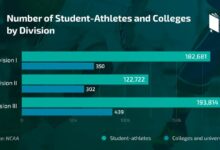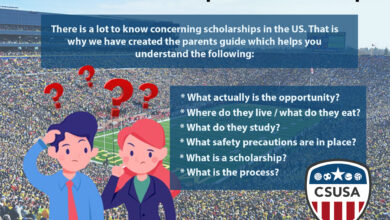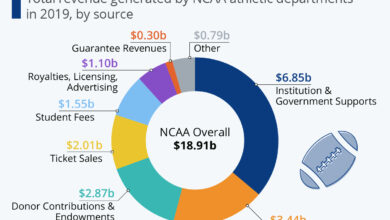Sports Scholarship Tips And Advice: Maximizing Opportunities For Student-Athletes
Sports scholarship tips and advice take center stage in this comprehensive guide, offering invaluable insights to student-athletes aiming to secure scholarships through a blend of athletic prowess and academic excellence. From understanding eligibility criteria to navigating the recruitment process, this resource equips aspiring athletes with the tools needed to succeed in their scholarship pursuits.
Introduction to Sports Scholarships
Sports scholarships are opportunities offered to student-athletes to pursue their education while continuing to excel in their respective sports. These scholarships provide financial assistance to cover tuition fees, accommodation, and other related expenses, allowing athletes to focus on their athletic and academic pursuits.
Benefits of Sports Scholarships for Student-Athletes
- Financial Support: Sports scholarships help student-athletes offset the high costs of attending college or university.
- Opportunity to Excel: Athletes can continue to hone their skills and compete at a high level while pursuing their education.
- Networking Opportunities: Scholarships can provide access to coaches, mentors, and resources that can help athletes advance in their sports careers.
- Recognition and Exposure: Student-athletes may gain recognition and exposure through their athletic achievements, opening up opportunities for future success.
Comparison to Academic Scholarships
While academic scholarships are based on academic merit, sports scholarships are awarded to athletes based on their athletic abilities and potential. Both types of scholarships aim to support students in pursuing their education, but sports scholarships specifically cater to individuals with exceptional athletic talents.
Examples of Famous Athletes Benefiting from Sports Scholarships
-
Michael Jordan
: The basketball legend received a sports scholarship to the University of North Carolina at Chapel Hill, where he showcased his skills before embarking on a successful NBA career.
-
Venus and Serena Williams
: The tennis superstars were able to develop their talents with sports scholarships, leading to multiple Grand Slam titles and worldwide recognition.
-
Tim Tebow
: The former NFL quarterback utilized a sports scholarship at the University of Florida, where he excelled both on the field and in the classroom.
Types of Sports Scholarships
Sports scholarships come in various forms, each with its own set of requirements and benefits. Here, we will delve into the different types of sports scholarships available and what you need to know to secure one.
Full-Ride Scholarships
Full-ride scholarships cover the entire cost of attending college, including tuition, room and board, and other expenses. These scholarships are highly competitive and typically reserved for top-tier athletes who excel both academically and athletically. To be eligible for a full-ride scholarship, students often need to maintain a high GPA, demonstrate exceptional athletic achievements, and provide strong recommendation letters from coaches or teachers. Application deadlines for full-ride scholarships vary by institution but are usually earlier than regular admissions deadlines.
Partial Scholarships
Partial scholarships, on the other hand, cover only a portion of the college expenses. While they may not cover all costs, partial scholarships can still significantly reduce the financial burden of attending college. The eligibility criteria for partial scholarships are similar to full-ride scholarships, but the academic and athletic requirements may be slightly less stringent. Application deadlines for partial scholarships also vary by school and sports program.
Tips for Finding and Applying for Sports Scholarships
– Network with coaches and attend sports camps and showcases to get noticed by college recruiters.
– Create a standout athletic resume highlighting your achievements, awards, and stats.
– Prepare for interviews by practicing common questions and showcasing your passion for your sport.
– Research different colleges and their athletic programs to find the best fit for your skills and goals.
Successful Athletes Who Have Benefited from Sports Scholarships
Many successful athletes have leveraged sports scholarships to further their academic and athletic careers. For example, basketball star LeBron James received a full-ride scholarship to play for the University of Akron before entering the NBA draft. This scholarship not only helped him pursue his passion for basketball but also opened doors for his future success both on and off the court.
Building a Strong Athletic Profile
Creating a strong athletic profile is crucial for student-athletes looking to secure sports scholarships. This profile serves as a snapshot of your skills, achievements, and potential, showcasing to coaches and recruiters why you are a valuable asset to their team.
Key Components of an Athletic Profile
- Statistics: Include relevant stats such as personal bests, game statistics, and physical measurements to highlight your capabilities.
- Achievements: Outline your accomplishments, awards, and recognitions in your sport to demonstrate your dedication and success.
- Highlight Videos: Share videos showcasing your skills, technique, and gameplay to provide recruiters with a visual representation of your abilities.
- Recommendations: Request recommendations from coaches, trainers, or mentors who can vouch for your work ethic, attitude, and talent.
Tips for Showcasing Skills Effectively
- Create a professional and organized athletic resume or profile that includes all relevant information.
- Regularly update your statistics, achievements, and videos to reflect your progress and growth as an athlete.
- Utilize social media platforms to share your journey, connect with coaches, and showcase your skills to a wider audience.
- Attend sports camps, showcases, and tournaments to gain exposure and demonstrate your abilities in a competitive setting.
Role of Coaches and Mentors
- Seek guidance and feedback from experienced coaches and mentors to help you improve your skills and develop a strategic plan for your athletic career.
- Collaborate with coaches to create a training program that will enhance your strengths and address areas for improvement.
- Engage with mentors who can offer valuable advice, support, and networking opportunities to assist you in achieving your sports scholarship goals.
Academic Excellence and Sports Scholarships
Academic performance plays a crucial role in securing sports scholarships, as colleges and universities often look for student-athletes who can excel both on the field and in the classroom. Balancing academics and athletics is essential for maximizing scholarship opportunities and setting yourself up for success in both areas.
Significance of Academic Performance
Maintaining a strong GPA, impressive standardized test scores, and a high class rank can significantly impact your chances of receiving sports scholarships. Academic excellence demonstrates your commitment to your studies and your ability to succeed in a challenging academic environment, which is highly valued by scholarship committees.
- Strive for a high GPA: Focus on your studies and prioritize academic success alongside your athletic pursuits. A strong GPA showcases your dedication to your education.
- Aim for impressive standardized test scores: Prepare thoroughly for exams like the SAT or ACT to demonstrate your academic abilities to potential scholarship providers.
- Excel in class rank: Climbing the ranks in your class shows that you are a top-performing student, which can set you apart from other applicants.
Tips for Balancing Academics and Athletics
It can be challenging to juggle the demands of sports and academics, but with proper time management and focus, you can maintain excellence in both areas. Here are some strategies to help you balance your commitments effectively:
- Create a study schedule: Plan out dedicated study time each day to stay on top of assignments and prepare for exams.
- Communicate with teachers: Keep your teachers informed about your athletic schedule, so they can support you and provide any necessary accommodations.
- Prioritize tasks: Identify your most important assignments and tasks, and tackle them first to ensure you meet academic deadlines.
Navigating the Recruitment Process
Navigating the recruitment process for sports scholarships in basketball is crucial for aspiring student-athletes. Understanding the roles of key individuals involved, creating an effective recruitment video, and maintaining academic excellence are essential steps in securing a basketball scholarship.
Roles in Basketball Recruitment
College coaches play a significant role in the recruitment process for basketball scholarships. They evaluate players based on their skills, athleticism, and potential fit within their team. Scouts also assist in identifying talented players and providing recommendations to college coaches. Recruitment agencies may help connect student-athletes with college programs and provide guidance throughout the process.
Elements of a Basketball Recruitment Video
When creating a basketball recruitment video, include highlights of game footage showcasing various skills such as shooting, dribbling, defense, and teamwork. Introduce yourself with basic information like name, position, height, and contact details. Include full-game footage to demonstrate consistency and overall performance on the court.
Showcasing Basketball Skills in a Video
To effectively showcase basketball skills in a recruitment video, focus on demonstrating fundamental skills like shooting accuracy, ball handling, athleticism, and basketball IQ. Highlight individual strengths that set you apart from other players, such as exceptional speed, agility, or court vision. Emphasize teamwork and sportsmanship to showcase a well-rounded athletic profile.
Academic Performance in Recruitment
Academic performance plays a vital role in the recruitment process for basketball scholarships. Maintaining a strong GPA, taking challenging courses, and meeting eligibility requirements are essential for student-athletes. College coaches look for recruits who excel both on the court and in the classroom, as academic success demonstrates discipline, work ethic, and commitment to excellence.
Financial Planning and Scholarships
When it comes to sports scholarships, understanding the financial aspects is crucial for student-athletes. From budgeting to managing scholarship funds, it’s important to be well-informed to make the most of this opportunity.
Terms and Conditions of Sports Scholarships
- Read the fine print: Before accepting a sports scholarship, make sure you fully understand the terms and conditions attached to it. This includes academic requirements, athletic performance expectations, and any other obligations.
- Renewal criteria: Scholarships may have specific criteria that need to be met for renewal each year. Be aware of these requirements to ensure you maintain your funding throughout your college career.
- Consequences of non-compliance: Failure to meet the terms of your sports scholarship could result in loss of funding. Stay informed and communicate with your coaches and academic advisors to avoid any issues.
Additional Financial Aid Options for Student-Athletes
Aside from sports scholarships, student-athletes have other financial aid options to explore:
- Grants and work-study programs: These can provide additional funding to cover expenses not included in your scholarship, such as textbooks, equipment, and living costs.
- Student loans: While not ideal, student loans can be a way to supplement your financial aid package. Be sure to research different loan options and understand the repayment terms.
- Athletic department assistance: Some colleges offer financial assistance programs through their athletic departments to help student-athletes with specific needs or emergencies.
Balancing Sports, Academics, and Social Life
Maintaining a healthy balance between sports, academics, and social life is crucial for student-athletes. Time management and self-care play a significant role in achieving this balance. Here are some strategies and tips to help student-athletes navigate their commitments effectively.
Importance of Time Management
Effective time management is key to balancing sports, academics, and social life. Student-athletes should create a weekly schedule that allocates time for each aspect of their life. Prioritize tasks, set realistic goals, and avoid procrastination to stay on track.
Avoiding Burnout and Staying Motivated
To avoid burnout, it’s essential for student-athletes to listen to their bodies and minds. Incorporate rest days into your schedule, practice stress-relief techniques, and stay connected with friends and family for emotional support. Setting short-term and long-term goals can help maintain motivation.
Creating a Balanced Schedule
A balanced schedule should include dedicated time for academics, sports training, competitions, social activities, and relaxation. Use effective study techniques like the Pomodoro method, active learning, and creating study groups to optimize academic performance.
Communication and Support
Open communication with coaches and teachers is crucial when feeling overwhelmed. Seek support from mentors, counselors, or sports psychologists to navigate challenges. Incorporating relaxation techniques like mindfulness or meditation can help reduce stress and improve focus.
Setting Goals for Success
Setting SMART goals for sports and academics can provide direction and motivation. Break down larger goals into smaller, manageable tasks to track progress. Regularly reassess your goals and adjust your schedule as needed to stay on target.
Seeking Support and Guidance
Student-athletes should not hesitate to seek support or guidance when struggling to balance their responsibilities. Utilize resources provided by the school, sports programs, or external organizations to access mentorship, mental health services, or academic support.
Injury Prevention and Recovery
In sports, injury prevention and recovery are crucial aspects for student-athletes to maintain their performance and overall well-being. Proper techniques and strategies can help athletes stay healthy and continue pursuing their athletic goals.
Importance of Injury Prevention
- Proper warm-up and cool-down routines can help prevent muscle strains and injuries.
- Strength and flexibility training can improve overall physical condition and reduce the risk of injuries.
- Using proper equipment and gear specific to the sport can also prevent accidents and injuries.
Proper Training Techniques
- Gradually increase intensity and duration of workouts to avoid overtraining and minimize the risk of injuries.
- Focus on proper form and technique during exercises to prevent unnecessary strain on muscles and joints.
- Listen to your body and rest when needed to allow for adequate recovery between training sessions.
Recovery Process for Injured Student-Athletes
- Follow the guidance of medical professionals for proper treatment and rehabilitation of injuries.
- Stay patient and committed to the recovery process, allowing the body enough time to heal effectively.
- Engage in low-impact activities or exercises recommended by healthcare providers to maintain fitness levels during recovery.
Mental and Emotional Support Resources
- Seek support from coaches, teammates, and sports psychologists to address any mental or emotional challenges during the recovery period.
- Participate in support groups or counseling sessions to cope with the stress and frustration of being sidelined due to injuries.
- Practice visualization techniques and positive self-talk to maintain a strong mindset and motivation throughout the recovery journey.
Mental Toughness and Sports Scholarships
Mental toughness plays a crucial role in the pursuit of sports scholarships. Student-athletes need to develop a strong mindset to overcome challenges, setbacks, and maintain focus on their goals. Here are some strategies and tips to enhance mental resilience in the context of sports scholarships.
Developing a Strong Mindset
- Utilize visualization techniques to mentally prepare for competitions and challenges.
- Set clear, achievable goals to stay motivated and focused on improvement.
- Practice positive self-talk to boost confidence and overcome doubts.
Overcoming Setbacks and Challenges
- Learn from failures and use them as opportunities for growth and improvement.
- Stay resilient in the face of adversity, maintaining a positive attitude and determination.
- Seek support from coaches, mentors, and peers to navigate tough times and stay motivated.
Success Stories of Resilient Student-Athletes
- Share examples of athletes who faced obstacles but persevered to achieve their sports scholarship goals.
- Highlight how these individuals stayed focused, maintained mental toughness, and balanced their athletic and academic responsibilities.
Importance of Work-Life Balance and Support System
- Emphasize the significance of maintaining a healthy balance between sports, academics, and personal life to prevent burnout.
- Encourage student-athletes to seek guidance and help from their support system to enhance mental toughness and performance.
Choosing the Right College for Sports Scholarships
When it comes to choosing the right college for sports scholarships, there are several important factors to consider. From academic reputation to scholarship opportunities, each aspect plays a crucial role in finding the perfect fit for your athletic and academic goals.
Division I, II, and III College Sports Programs
- Division I colleges offer the highest level of competition, but they also require a significant time commitment from student-athletes. Scholarships are more readily available at this level.
- Division II colleges provide a balance between competition and academics, with fewer time demands compared to Division I. Scholarships are available but may be less than at the Division I level.
- Division III colleges prioritize academics over athletics, offering a more balanced approach to student-athlete life. While scholarships are not based on athletic performance, financial aid is available.
Researching Colleges and Athletic Programs
- Explore the success of the team in your chosen sport, as well as the coaching staff and facilities available for athletes.
- Consider the academic support provided to student-athletes, including tutoring services and study halls.
- Look into the alumni network of the college and how it can benefit you in your future career.
Making the Final Decision
- Visit the campus to get a feel for the environment and meet with current student-athletes to understand their experiences.
- Schedule meetings with coaches to discuss your athletic goals and scholarship opportunities.
- Understand the criteria for scholarship renewal to ensure you can maintain your funding throughout your college career.
Pros and Cons Comparison Table
| College | Academic Offerings | Athletic Facilities | Scholarship Packages | Campus Life |
|---|---|---|---|---|
| College A | Strong programs in your field of study | State-of-the-art training facilities | Full-ride scholarship available | Vibrant campus with plenty of extracurricular activities |
| College B | Varied academic options to explore | Decent athletic facilities for training | Partial scholarship offered | Close-knit community atmosphere |
| College C | Focus on practical learning experiences | Basic facilities but adequate for training | Merit-based scholarships available | Relaxed campus environment |
Life After Sports Scholarships
After years of dedication to your sport while balancing academics, the transition from college athletics to post-graduation life can be both exciting and challenging. It’s essential for student-athletes to start planning for their careers beyond sports while still in school to ensure a smooth transition.
Tips for Career Planning
- Start exploring different career paths early on and consider internships or job shadowing opportunities to gain experience.
- Connect with alumni who were former student-athletes to learn about their career paths and seek mentorship.
- Utilize resources provided by your college’s career center to build a strong resume and cover letter tailored to your skills and experiences.
- Attend career fairs and networking events to expand your professional connections and explore potential job opportunities.
Importance of Networking and Transferable Skills
Networking is crucial for student-athletes looking to transition into a career outside of sports. Building relationships with professionals in your field of interest can open doors to job opportunities and mentorship. Additionally, highlighting transferable skills acquired through sports such as teamwork, leadership, time management, and discipline can make you a valuable candidate in the job market.
Success Stories of Athletes in New Careers
One example is former NBA player Shaquille O’Neal, who successfully transitioned to a career in broadcasting and entrepreneurship after retiring from basketball.
Another example is Olympic gymnast Shannon Miller, who became a successful businesswoman and motivational speaker post-retirement from competitive gymnastics.
Social Media and Personal Branding for Student-Athletes
Social media plays a significant role in the world of sports scholarships, offering student-athletes a platform to showcase their skills and connect with coaches, recruiters, and fans. It is crucial for student-athletes to understand the impact of social media on their athletic careers and to utilize it effectively to build a strong personal brand.
Creating a Professional Online Presence
Creating a professional online presence is essential for student-athletes looking to attract the attention of college coaches and recruiters. Here are some tips to help you establish a strong presence on social media:
- Ensure your profiles are public and showcase your athletic achievements, academic excellence, and extracurricular activities.
- Use professional photos and videos that highlight your skills and dedication to your sport.
- Engage with your followers by sharing updates about your training, competitions, and achievements.
- Regularly update your profiles with new content to keep your audience engaged and informed.
Dos and Don’ts of Personal Branding for Student-Athletes
When it comes to personal branding, it’s important for student-athletes to maintain a consistent brand image across different social media platforms. Here are some dos and don’ts to keep in mind:
- Do: Post content that reflects your values, work ethic, and dedication to your sport.
- Don’t: Share controversial or inappropriate content that could damage your reputation and affect your chances of securing a sports scholarship.
- Do: Engage with fans and followers in a positive and meaningful way to build a loyal and supportive community.
- Don’t: Respond to negative comments or feedback in a defensive or confrontational manner; instead, address them professionally or ignore them altogether.
Networking with Coaches, Recruiters, and Sponsors
Social media provides student-athletes with a powerful tool for networking with coaches, recruiters, and potential sponsors. Here are some strategies to help you make the most of social media for networking purposes:
- Follow college coaches and recruiters from the schools you’re interested in to stay updated on their programs and recruitment needs.
- Engage with their posts by liking, commenting, and sharing relevant content to show your interest and enthusiasm.
- Connect with sponsors and brands that align with your values and goals as an athlete to explore potential sponsorship opportunities.
- Use direct messaging to reach out to coaches, recruiters, and sponsors to introduce yourself and express your interest in their programs or products.
Diversity and Inclusion in Sports Scholarships
Creating a diverse and inclusive environment in sports scholarships is crucial for fostering a sense of belonging and equal opportunities for all student-athletes.
Importance of Diversity and Inclusion
Promoting diversity and inclusion in sports scholarships not only benefits the individual student-athletes but also enriches the overall athletic community. It allows for different perspectives, experiences, and talents to thrive, leading to a more well-rounded and competitive sports program.
Initiatives for Promoting Diversity
- Establishing mentorship programs for student-athletes from underrepresented backgrounds.
- Hosting diversity and inclusion workshops and training sessions for coaches and staff.
- Implementing recruitment strategies that actively seek out talent from diverse communities.
Creating an Inclusive Environment
- Encouraging open communication and dialogue among student-athletes, coaches, and staff.
- Celebrating and showcasing the achievements of student-athletes from diverse backgrounds.
- Providing resources and support systems for student-athletes facing unique challenges.
Stories of Success
Many athletes from underrepresented backgrounds have defied the odds and excelled in their respective sports. Their stories serve as inspiration and proof that diversity and inclusion in sports scholarships can lead to remarkable achievements.
Community Engagement and Giving Back
Community engagement plays a vital role in the development of student-athletes beyond their athletic abilities. It allows them to give back to the community, develop essential life skills, and make a positive impact beyond the field.
Role of Student-Athletes in Community Engagement
- Student-athletes serve as role models in the community, inspiring and motivating others to pursue their goals.
- They have the platform to raise awareness about important social issues and contribute to meaningful causes.
- By engaging in community service, student-athletes learn empathy, leadership, and teamwork skills that are valuable both on and off the field.
Examples of Community Service Opportunities for Student-Athletes
- Volunteering at local schools or youth sports programs
- Organizing sports clinics or events for underprivileged children
- Participating in environmental clean-up initiatives
Benefits of Giving Back to the Community
- Enhanced sense of fulfillment and purpose
- Development of leadership and communication skills
- Building strong connections with the community
Balancing Academic, Athletic, and Community Service Commitments
- Prioritize time management and create a schedule to allocate time for each commitment
- Communicate effectively with coaches, teachers, and community organizations to coordinate activities
- Set realistic goals and expectations for each area of involvement
Long-Term Impact of Community Service on Student-Athletes
- Enhanced personal growth and character development
- Increased awareness of social issues and the importance of giving back
- Strengthened relationships within the community and beyond
Comparison of Community Service Requirements in High School vs College
- In high school, community service may be a graduation requirement, while in college, it is often voluntary but highly encouraged.
- College student-athletes may have access to more resources and opportunities for community engagement compared to high school athletes.
- Both levels emphasize the importance of giving back and making a positive impact in the community.
Step-by-Step Guide for Initiating Community Service Projects
- Identify a cause or issue that you are passionate about.
- Research local organizations or initiatives related to the cause.
- Reach out to community leaders or organizations to discuss potential collaboration.
- Create a detailed plan outlining goals, tasks, and timelines for the project.
- Recruit volunteers and promote the project within your network and community.
- Evaluate the impact of the project and reflect on what you have learned from the experience.
Last Recap
In conclusion, the journey towards securing a sports scholarship is one filled with challenges and opportunities. By following the tips and advice outlined in this guide, student-athletes can enhance their chances of not only obtaining financial support but also thriving academically and athletically.









